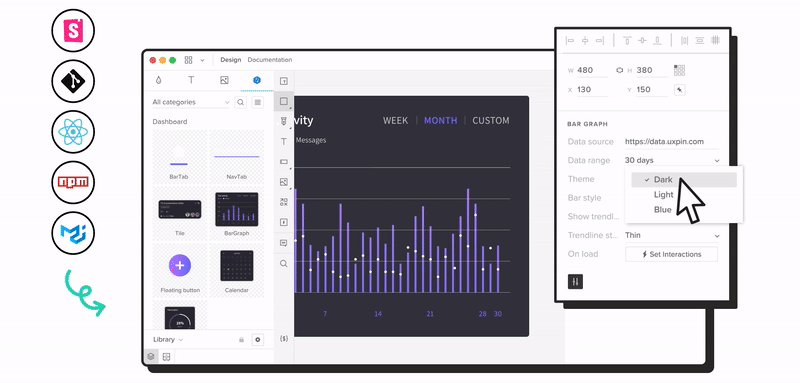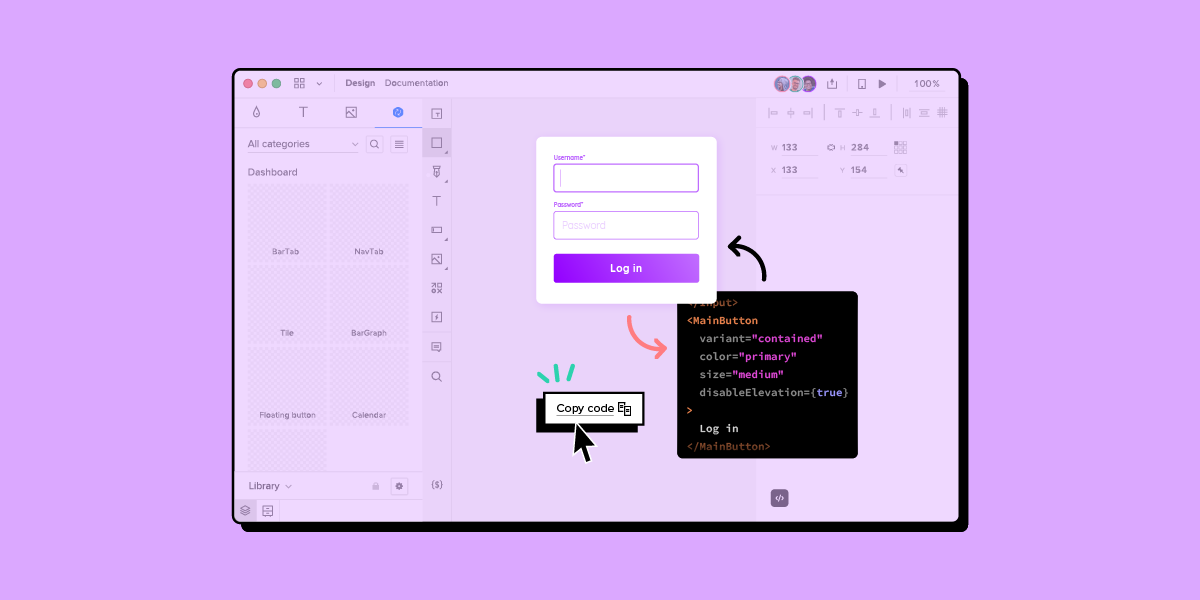Build life-like prototypes in minutes in UXPin
Eliminate friction between product teams. Use components with built-in interactivity coming from a code-based library instead of drawing vector-based mockups

The traditional UX design process is broken. In one room we have designers creating vector-based mockups with their own special toolkits and processes. In another, we have developers building products based on those mockups with a completely different toolset, mindset and methodology.
With the two teams working in such a disconnected way, the product pipeline is hamstrung by inconsistencies and inefficiencies because it’s a process that has a huge communication burden baked into it. The final product rarely matches what the designers intended, resulting in lots of back and forth at the handoff stage which wastes time. A siloed style of working also makes product design and development tough to scale because the inefficiencies call for unfeasibly large teams.

The key to both streamlining the production process and to scaling it up is to get both sides working with the same components. Instead of drawing their own interface elements, designers use the actual components from the developer’s component library so both teams are working with the same materials. This way, there’s a single source of truth so everyone agrees about exactly what the prototype should look like and how it should work.
Designers no longer need to link to static artboards to simulate interaction, because they are using the fully functional elements that will appear in the end product. This approach also allows for product managers and developers to be included in the design process, which is essential for scaling the product pipeline.
Enter: Component-driven prototyping
UXPin with Merge technology enables designers to prototype with coded UI components shared across design and development teams. The components can be imported from a Git repository, Storybook or—a recently released integration—an npm package, which you can try with a free UXPin trial.
The result – designers are prototyping with components that have already been tested and aligned with the design system, saving time for themselves and ensuring consistency across design and development. As they are working with the final UI elements, component-driven prototyping removes design drift between the original design and the developers’ version. This eliminates back and forth between teams and shortens the time to market.
Dragging and dropping the imported components to create a prototype is so straightforward that design teams can build advanced app prototypes in minutes to hours, instead of months. Even product teams can build a prototype and get it reviewed quickly by a designer instead of waiting for someone to make it for them. This approach removes the UX design bottleneck and frees designers to work on big-picture design problems.
How PayPal supercharged their product pipeline
For PayPal, including product teams in the design process was key to scaling their pipeline. They were able to put their Microsoft Fluent Design System into a Github repo and import the components into UXPin’s design editor using Merge, enabling their product teams to create high fidelity, error-free prototypes.
With their old system it would take two or three months just to design mockups for a one-page product—now their product teams can design and deliver the whole project within the same time frame.
The high fidelity prototypes have been a game-changer at PayPal because they facilitate much stronger feedback from stakeholders and improve the quality of the final product.
Transferring the prototyping work from designers to product teams has enabled PayPal to scale and restructure their design process, and transform the role of their designers.
The UX team now operate as design mentors, spending around half their time supporting product teams and the other half working on overarching UX initiatives that impact the organisation as a whole.
Faster time to market with Merge technology
Merge technology enables you to engage engineering and product teams throughout the design process, removing inefficiencies and frustrations and ultimately getting your product out faster than ever before. Want to try it out? Request access here to supercharge your design process with Merge!

Thank you for reading 5 articles this month* Join now for unlimited access
Enjoy your first month for just £1 / $1 / €1
*Read 5 free articles per month without a subscription

Join now for unlimited access
Try first month for just £1 / $1 / €1
Get the Creative Bloq Newsletter
Daily design news, reviews, how-tos and more, as picked by the editors.
The Creative Bloq team is made up of a group of design fans, and has changed and evolved since Creative Bloq began back in 2012. The current website team consists of eight full-time members of staff: Editor Georgia Coggan, Deputy Editor Rosie Hilder, Ecommerce Editor Beren Neale, Senior News Editor Daniel Piper, Editor, Digital Art and 3D Ian Dean, Tech Reviews Editor Erlingur Einarsson, Ecommerce Writer Beth Nicholls and Staff Writer Natalie Fear, as well as a roster of freelancers from around the world. The ImagineFX magazine team also pitch in, ensuring that content from leading digital art publication ImagineFX is represented on Creative Bloq.
